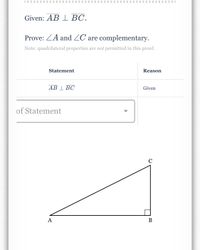
Advanced Engineering Mathematics
10th Edition
ISBN: 9780470458365
Author: Erwin Kreyszig
Publisher: Wiley, John & Sons, Incorporated
expand_more
expand_more
format_list_bulleted
Concept explainers
Topic Video
Question

Transcribed Image Text:**Given:** \( \overline{AB} \perp \overline{BC} \).
**Prove:** \(\angle A\) and \(\angle C\) are complementary.
**Note:** Quadrilateral properties are _not_ permitted in this proof.
---
| Statement | Reason |
|-------------------------|--------|
| \( \overline{AB} \perp \overline{BC} \) | Given |
---
**Diagram Explanation:**
The diagram depicts a right triangle with vertices labeled \(A\), \(B\), and \(C\).
- The line segment \( \overline{AB} \) is perpendicular to \( \overline{BC} \), forming a right angle (90 degrees) at vertex \(B\). This right angle is indicated with a small square at \(B\).
- The triangle is oriented such that \(A\) and \(C\) are the other two vertices, and their position in the triangle signifies the angles to be evaluated as complementary.
**Concepts Used:**
Complementary angles are two angles whose measures add up to 90 degrees. In a right triangle, the two non-right angles are always complementary because the sum of all angles in any triangle is 180 degrees, and the right angle itself accounts for 90 degrees.
Expert Solution
arrow_forward
Step 1
_1.jpg)
Step by stepSolved in 2 steps with 1 images

Knowledge Booster
Learn more about
Need a deep-dive on the concept behind this application? Look no further. Learn more about this topic, advanced-math and related others by exploring similar questions and additional content below.Similar questions
arrow_back_ios
arrow_forward_ios
Recommended textbooks for you
 Advanced Engineering MathematicsAdvanced MathISBN:9780470458365Author:Erwin KreyszigPublisher:Wiley, John & Sons, Incorporated
Advanced Engineering MathematicsAdvanced MathISBN:9780470458365Author:Erwin KreyszigPublisher:Wiley, John & Sons, Incorporated Numerical Methods for EngineersAdvanced MathISBN:9780073397924Author:Steven C. Chapra Dr., Raymond P. CanalePublisher:McGraw-Hill Education
Numerical Methods for EngineersAdvanced MathISBN:9780073397924Author:Steven C. Chapra Dr., Raymond P. CanalePublisher:McGraw-Hill Education Introductory Mathematics for Engineering Applicat...Advanced MathISBN:9781118141809Author:Nathan KlingbeilPublisher:WILEY
Introductory Mathematics for Engineering Applicat...Advanced MathISBN:9781118141809Author:Nathan KlingbeilPublisher:WILEY Mathematics For Machine TechnologyAdvanced MathISBN:9781337798310Author:Peterson, John.Publisher:Cengage Learning,
Mathematics For Machine TechnologyAdvanced MathISBN:9781337798310Author:Peterson, John.Publisher:Cengage Learning,


Advanced Engineering Mathematics
Advanced Math
ISBN:9780470458365
Author:Erwin Kreyszig
Publisher:Wiley, John & Sons, Incorporated

Numerical Methods for Engineers
Advanced Math
ISBN:9780073397924
Author:Steven C. Chapra Dr., Raymond P. Canale
Publisher:McGraw-Hill Education

Introductory Mathematics for Engineering Applicat...
Advanced Math
ISBN:9781118141809
Author:Nathan Klingbeil
Publisher:WILEY

Mathematics For Machine Technology
Advanced Math
ISBN:9781337798310
Author:Peterson, John.
Publisher:Cengage Learning,

